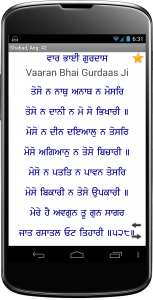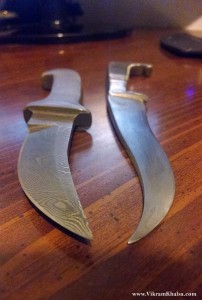[Review] Khalsa Armory Kirpans
The Kirpan is often translated as a “Sikh Ceremonial Dagger”, but it is a whole lot more than that. It does have a lot of spiritual significance, but it is also meant to be practical and usable, if the need arises. As something a Sikh is supposed to carry on their person at all times, the Kirpan should be a high quality shastar, not the mass produced sheet of metal cut into a Kirpan shape that we often see today.
Allow me to introduce Khalsa Armory. Started by a young Singh from the Fresno area, KA describes itself as “A Knife & Arms company founded on 3 solid values. Q.U.A. ; Our products will show Quality, Uniqueness & Affordability!“. Today I will evaluate how well this statement holds up under closer scrutiny. I had the opportunity to check out the KA stall at the Yuba City Nagar Kirtan and take home a few pieces to test out. Let me briefly describe the 4 test models I got to spend time with and then I can discuss what I thought of them.
DK-2 – KA’s original flagship product ( the DK-1) wasn’t available when I got the review units, so I’m taking a look at the DK-2, which is the next closest thing. The main difference here is that that the DK-1 is a solid 1 piece Kirpan in which the handle is made of the same metal as the blade. The DK-2 has micarta grips on the sides of the handle which makes it lighter in weight and lower in price.
DK-3 – The DK-3 is a slimmed down version of the DK-1, where the handle has been cut down in width. So overall the Kirpan is lighter, and has a slimmer profile. The blade also has a tapered curve towards the back edge, which gives it a really cool sleek look. However, the slimmer handle doesn’t feel as nice in the hand due to its sharper edges.
DK-4 – A smaller sized Kirpan, the DK-4 is a single piece design, similar to a Taksali or traditional Kirpan with the smaller rounder handle. Sort of like a mini DK-1, it has a nice feel in the hand and nice blade as well.
DK-5 – Another smaller model, the DK-5 sports a small but beautiful wood-like handle. It is harder to hold on to if you were actually cutting something, but it can be carried daily or kept on the person, since the handle isn’t too top heavy. The blade is nice and sharp and features a beautiful design.
Photo Credit: Ikonkar Kaur Jan 2014.
Quality: 8/10
There is no doubt as to the quality of these Kirpans. The workmanship that went into them is apparent as soon as you pick one up. They are very well made, and the subtle design elements really show the creator’s attention to detail. I’ve seen Khalsa Armory get to where it is today so I know that it went through a few iterations before they released this design as their standard. I’m confident that these Kirpans will last, and I’m sure they could take on any task thrown at them. The Damascus blade is made from different layers of steel folded together, resulting in a very strong and sharp Kirpan. They are definitely better quality than the mass produced Indian or Chinese “Kirpans”. Although not as fancy or complex as some others, the kydex sheaths do a great job of protecting the blade. The Kirpan won’t fall out or get stuck in one – it takes just the right amount of pull to slide it out.
Affordability: 7/10
I would say that these Kirpans are relatively affordable. While they are much more expensive than the average cheap Kirpans from India, they are also significantly better in terms of quality. In my opinion, the price difference is worth it – I would rather depend on a KA Kirpan than one of those. The Kirpans from Khalsa Armory are much closer to the price range of Taksali Kirpans (outside of India). However, in comparison to most other fancy artisan Kirpans (such as Khalsa Kirpans) they are much cheaper by far. A quick round at Yuba City Nagar Kirtan will show you how expensive nice fancy Kirpans can get, and KA ends up on the affordable side of the spectrum. It is important to note, however, that these do have simple sheaths as opposed to the intricately designed scabbards of some more expensive Kirpans, which may be engraved, embedded with previous stones or covered with expensive materials such as silver or gold.
Uniqueness: 9/10
These Kirpans are definitely unique. The single piece design and curve of the blades is different from both the traditional Kirpans we see and western knives as well. I would put the design somewhere in between – its like a western style blade with a Kirpan-like curve. The Damascus mixture of metal layers isn’t seen often these days and the swirly design is beautiful. Each Kirpan has a unique pattern, and the intricate etchings, cuts and patterned handles give these Kirpans their own personality. The blade covers also make these Kirpans stand out from others, since we never really see Kirpans with tactical sheaths. The handle shape is also different from many other Kirpans, as is the feel, size and weight.
Final Thoughts:
Khalsa Armory Kirpans are really really nice. Their blades are relatively sharp and much stronger than typical Kirpan blades. Whereas traditional Kirpan blades are thick at the back edge and gradually taper off into the blade, these blades are thick for about half the width of the blade, after which they slowly slope down to a sharp edge. Depending on the material, this added thickness plus the pattern and curve of the blade can make it harder to cut something. But the blade also has enough strength to push all the way through a tough material. I found them to be just a little sharper than my fairly well sharpened Taksali style kirpan. I personally wouldn’t wear any of these as my daily Kirpan because the blade is made of a mix of metals rather than Sarbloh (or what we call Sarbloh today), and because they are quite heavy. The top heavy design means they will tilt forward a lot in the Gatra. The sheath also has its pros and cons – being wider and flatter means sharper edges and an awkward Gatra fit, but they are also flatter against your body and there is no protruding tip (less damage to clothes and hard to poke yourself). All of that being said, I would definitely wear this Kirpan over the top – it not only makes for a beautiful display piece but it is a usable Shastar as well.
At the end of the day, Khalsa Armory Kirpans offer a beautiful design combined with solid quality at a fair price. I would definitely recommend these to anyone interested, whether its for a collection or to wear. They make a lot of other cool stuff including carbon fiber and titanium Shastars, and I’m always looking forward to their future products. For a limited time they are offering FREE SHIPPING with the coupon code “KAVSK”!
Check them out at : www.khalsaarmory.com or https://www.facebook.com/KhalsaArmory
Posted in Sikhi, Stuff and tagged custom, gift, khalsa, sikh, singhwith no comments yet.
Top 6 Gurbani Apps for Android
Update: Since this is one of my most popular posts – I wanted to let all the readers know about a new and more up to date resource for Gurbani apps and Sikh Tech in general – the Sikho Youtube channel. This channel will have videos, tutorials, guides and reviews for Sikh apps, websites, and resources and highly recommend you check it out. Feel free to continue reading the post below but know that the information may be a little outdated, although still valuable.
 Although they cannot provide the same experience as using an actual Gutka or doing paath from a physical saroop of Sri Guru Granth Sahib Ji, smartphones and modern devices allow us to read Baani or sing shabads anytime, anywhere. They come in handy for kirtan when a projector system is not available, both for the kirtanee and sangat. There have been some great apps developed for iOS, and with the increasing popularity of the Android platform, many more Gurbani apps are becoming available – each with its own share of unique features. In this article I will be reviewing the 6 best Gurbani Search apps available on the Google Play Store. Each app is described along with a basic run down of its features, pros/cons, and screenshots. The Play Store links are included, so you can read the official descriptions and download them directly.
Although they cannot provide the same experience as using an actual Gutka or doing paath from a physical saroop of Sri Guru Granth Sahib Ji, smartphones and modern devices allow us to read Baani or sing shabads anytime, anywhere. They come in handy for kirtan when a projector system is not available, both for the kirtanee and sangat. There have been some great apps developed for iOS, and with the increasing popularity of the Android platform, many more Gurbani apps are becoming available – each with its own share of unique features. In this article I will be reviewing the 6 best Gurbani Search apps available on the Google Play Store. Each app is described along with a basic run down of its features, pros/cons, and screenshots. The Play Store links are included, so you can read the official descriptions and download them directly.
Being an Android user myself, I’m so glad that these apps are available and I want other users to be aware of them too. Most of them have been developed individually or by small groups, and they are all free. So a huge thanks to all of the developers who did this great seva and provided the sangat with a wide range of resources – I’m sure everyone can find something that fits their needs.
6. Sikhitothemax
By: Singh
Size: 153 kb (App downloads database separately)
Download
Android users may often download this app because of its well established name. However, there is nothing which says this app was developed by the same team that created the desktop software and website SikhiToTheMax. Rather, it seems that this was a private effort. When opening the app, it takes you straight to the search screen which has a Gurmukhi keyboard with nice large buttons that are clearly readable. The “first letters” search function works well, but it only searches Baani of Sri Guru Granth Sahib Ji; there are no results from Dasam Granth Sahib or Bhai Gurdas Ji’s Vaars. In shabad view, the app lets you go to the previous and next shabads. This is handy, although I wish the buttons at the top weren’t so big as they take up a lot of space from the screen. The layout is clean and clear. Settings are accessible from both the search page and Shabad view (by pressing your phone’s menu button), and include some great features such as light/dark backgrounds, different font options, and the ability to toggle the English translations. Overall this is a solid app that gets the job done, but lacks many of the advanced features that are available in other android apps.
Pros: Gurmukhi keyboard, adjustable font size, light/dark themes, hide/enable english, in-shabad menu access
Cons: delete button clears all letters – have to start again, no Dasam Bani or Bhai Gurdas, no favorites, no Baani or Granth view
5. Dhur Ki Baani
By Khalsa
Size: 6.24 mb
Download
This app has been available for a long time, and it provides a solid set of features. Upon opening the app, users are greeted with a simple home screen that has 3 options: Sikh Prayers, Search By Ang, and Search By Shabad. This app features a basic Nitnem Gutka built in, with the 7 daily Baania and Ardaas. The cool thing is that everything has English transliteration as well, so if you can’t read Gurmukhi you can still do paath. All the font sizes are adjustable as well. The search by ang feature is great too, if you know the ang number in SGGS you can just go right to it. The Search by Shabad option works well, with the usual first letters mechanism. However, you must type with your standard English keyboard and the letters appear in English. The other annoying thing is that you have to put spaces between the letters, unlike most other apps. The app only searches SGGS and does not include other sources such as Bhai Gurdas Ji or Dasam Bani. You can save a Shabad as a bookmark and view it later, and you can also conveniently take a screenshot with a special button right in the app. The app lets you navigate to the previous and next Shabads. There is a settings menu that you can access from the home screen, but if you are viewing a Shabad, you have to go back to the home page to change settings and then search for the Shabad again. Although the design looks a little bit outdated, this app is a great effort and works well.
Pros: Adjustable font size, toggle-able transliteration and translations, bookmarks, sreenshot, Nitnem Guttka, Search by Ang
Cons: No Dasam Baani or Bhai Gurdaas Ji, Menu only accessible from home, need spaces in search, English keyboard, English letters
4. iGranth
By: Richipal Singh
Size: 11.88mb.
Download
This was my favorite Gurbani search application for a really long time, and I still recommend it. The interface is clean, simple, and right to the point. Opening the app takes you right to the search screen, which has a Gurmukhi keyboard. The keys are big but the letters are very small, and people often have trouble reading them. But the ‘first letters anywhere’ search works pretty well. There is no menu or settings page – however, pressing the menu button in shabad view gives you the option to turn English translations on or off, or go straight to the corresponding SGGS page. The SGGS page viewer lets you navigate to any ang. You can also favorite the Shabads and access them later on. You can zoom in and out from the shabad view, which is very convenient. Some shabads have Punjabi viakhia but not all, for some reason. This app also includes a simple Nitnem Gutka that has the basic daily Baanis. The best thing about this app is that it also searches Dasam Baani, Bhai Gurdas Ji’s Vaaraa and even Bhai Nand Lal Ji and other compositions that are in Amrit Kirtan (Bhai Gurdaas Gingh, Rehitnamas, etc). All in all, a great app and usually my go-to choice.
Pros: Ability to zoom in shabad pages, turn off translations from page, favorites, share feature, Nitnem Gutka, go to ang, Gurmukhi keyboard, many compositions
Cons: Small Keyboard, no transliteration, can’t rearrange favorites, can’t change background or font color, punjabi translations incomplete
3. Gurbani Nirvaan
By: Vayu Waves
Size: 315 kb (App downloads database separately)
Download
I don’t use this app very often, but it actually has a lot of features, many of which are not available in other apps. The app’s home screen greets you with a random Shabad every time, which is great. If you look around you won’t find anything – you have to press the menu key in order to get some options (an older design style). You can read the full text from SGGS, Bhai Gurdas Ji, Dasam Granth, and a few specific Baania, and navigate within them by swiping left or right to change pages or go directly to a specific ang. The app also remembers the last place you left off so you can continue reading from there. There is a basic Nitnem Gutka that includes the standard daily Baanis. Whats great about the search function in this app is that you can search from first letters in Gurmukhi or English, and you can search for Gurmukhi words/phrases AND you can search for words in the English translation! It can search from SGGS, Dasam Bani, or Vaaran Bhai Gurdaas – but you have to select which source to search in. The most powerful feature of this app, in my opinion, is bookmark management. You can create different groups to put the bookmarks into, and change the order in which they appear. You can even edit the name of each bookmark to make it easier to find later on. Another unique and super cool feature about this app is that you can “pin” a Shabad to your home screen. So basically you can have a shortcut on your home screen that takes you directly to the Shabad you want, instead of trying to find it later – making it great for Kirtanis! This app may not be for everyone, but it has much to offer!
Pros: Dasam Granth & Bhai Gurdaas, Nitnem Gutka, word/english search, organized bookmarks, pin to homescreen, share
Cons: English keyboard, aged UI, need to select source when searching.
2. iSearch Gurbani
By: Gatway to Sikhism foundation
Size: 4.7mb (App downloads database separately)
Download
This app is strikingly similar to Gurbani Nirvaan. The home page once again shows a random shabad, and although the design is a little more aesthetically pleasing, it still uses the older menu paradigm. You won’t see any options until you press the menu button. You can read SGGS, navigate to any ang, swipe left and right to move forward or back, and you can zoom from within the shabad, so you don’t need to go into the menu. The Sundar Gutka/Baani list is very extensive and includes a lot more options than most of the other apps, including most of the Baanis in SGGS and some from Dasam Baani. This app also has Hindi and Romanization in addition to Gurmukhi and English translations. All the fonts sizes are adjustable and you can even pick some fancy Gurmukhi fonts, as well as change the background style. The search feature searches SGGS, Bhai Gurdaas, Dasam Bani and more all at once. But you have to remember to put spaces between the letters otherwise it won’t work. This apps lets you search using first letters or full words in english or in the transliteration. You can also save the shabads as favorites. The app also installs a gurmukhi keyboard in your phone that you can switch to make it easier for typing searches, but its annoying having to switch keyboards every time you use the app. Overall a very functional app that is also beautiful.
Pros: Hindi, English Transliteration, Sundar Gutka, go to ang, swipe and zoom from page view, adjustable font options, favorites, light/dark themes, searches all sources, includes gurmukhi keyboard, help menu
Cons: Need to put spaces between letters, separate Gurmukhi keyboard – need to switch input methods.
1. Gurbani Searcher
By: Surinder Pal Singh Bindra
Size: 21.99 mb.
Download
I have to admit, this is my favorite Gurbani App. I think its unmatched in the amount of features and the developer keeps updating it and making it better! As soon as you open the app there is a message saying Fateh and reminding users to cover their head to respect Gurbani. You can search with first letters anywhere or by individual words. The search is live, so the results start showing up as you type. There is a little icon that tells you what source the result is from. Unfrotunately the app doesn’t have a Gurmukhi keyboard built in, but the developer has one available to download separately. One of the best features of this app that others lack is pinch to zoom, the most intuitive way to change your text size. The author recently added a great menu that you can access by sliding from the left in shabad view, which lets you toggle English and Gurmukhi translations, as well as Hindi. An awesome unique feature is the auto-scroll, which scrolls the shabad down on its own. You can even adjust the speed, making it handy for following along Akhand Paath without the need to constantly touch your phone and scroll. You can save shabads to favorites, and then sort the favorites by raag, author, or even custom tags that you set . This can be very useful for kirtanees to organize their shabads into groups. You can also read SGGS, Bhai Nand Lal Ji, Bhai Gurdaas, Dasam Granth, and other compositions. The included Sundar Gutka has a wide selection of Baanis. You can view the Baani in scroll view or page view, which lets you turn pages in 3d. Other great features include live kirtan streaming, calendar, and exporting favorites. I think this is the most feature rich Gurbani App and it is designed well too.
Pros: Pinch to zoom, slide out menu, punjabi teeka & translation, hindi, recent history, sortable favorites, customize fonts and colors, hindi, live search, sundar gutka, page turning, auto scroll, bhai nand lal ji/rehit nama/compositions, calendar, kirtan, Larivar
Cons: no English transliteration, large app size, need to download Gurmukhi Keyboard separately
Well, those are the best Gurbani Search Apps I’ve found, seen, and used on Android devices. Thanks once again to all the developers and I hope readers found this article helpful. Go ahead and try a new app, you may end up liking it. There are a few great apps I left off of this list because they don’t fit the criteria for comparison (but they may be mentioned in a later article). Whats your favorite Sikhi app? If you have any other ideas, suggestions, or something I missed, please let me know in the comments below. Lets try to use these valuable resources and technology to connect more with our Guru!
Not using Android?
For iOS gurbani apps, check out this great post by Maneetpaul Singh:
http://www.maneetpaul.com/blog/2014/8/28/sikh-apps
Posted in Sikhi and tagged applications, banee, bani, dasam, granth, gurbani, gurmukhi, guru, gutka, kaur, keertan, khalsa, kirtan, mobile, nitnem, platform, sahib, sikhi, sikhism, singh, softwarewith no comments yet.
Qualities of a Keertani
Almost anyone can learn how to play and sing a shabad with a harmonium – but there is a lot more than that to doing keertan. Once I was at a divaan listening to Bhai Kultar Singh Ji doing keertan and vichaar. Bhai Kultar Singh is the son of well known raagi Bhai Avtar Singh, who did keertan in the puratan Gurmat Sangeet style. Bhai Sahib and his family have preserved musical traditions, compositions, raags and taals since the time of Guru Sahib and passed them down from generation to generation. At this divaan, Bhai Sahib shared some bits of wisdom with us that he learned from his father before he passed away. I have shared his points below, along with some of my own personal experiences and ideas. Keep in mind these aren’t official requirements written anywhere, they are just ideal guidelines that every keertani should follow.
1. A keertani should memorize the shabad they are going to do.
Although modern technology has been very helpful, I feel like it has also increased our dependence on external sources and caused our memories to become weaker. If our phone’s battery dies all of the sudden, we don’t know the next line of our shabad! If we have the shabad memorized, we won’t be dependent on a notebook, Amrit Kirtan Pothi, iPad, or other aid to help us. This means that we can sing or recite the shabad anytime, anywhere – and we wouldn’t be limited to having a source on us in order to do it. It may even help us focus because we wouldn’t have to keep opening our eyes and looking for the next line. Another point I realized was that in order to learn a shabad by heart, we would have to read it many times over and over again. This abhyaas (practice) and jaap will help the shabad ‘settle’ inside us. We get the added benefit of reading more bani and we are more likely to understand it this way too.
2. A keertani should know the meanings of the shabad.
We may think this is implied, or obvious; but you might be surprised how many of us don’t know the meanings of the shabads we are doing. Usually when young children are doing kirtan they don’t know what the shabad means, but it happens with adults too. It is our responsibility to teach and explain the meanings to kids and to learn them ourselves as well. Understanding the meanings of a shabad will also help us with correct pronunciation and bisraams (pauses). These can be very important, as incorrect ucharan and bisraams can totally change the meaning of a line. If we don’t try to understand the shabad before hand, we may assume some incorrect definitions, and make mistakes like doing Waheguru Simran where it does not apply or is completely irrelevant.
Once I was sitting in a large kirtan divaan, and a prominent keertani was singing the shabad ਹਮ ਵਣਜਾਰੇ ਰਾਮ ਕੇ ||(I am the merchant/trader of the Lord). When he got to the first half of the line ਹੋਰੁ ਵਣਜੁ ਕਰਹਿ ਵਾਪਾਰੀਏ ਅਨੰਤ ਤਰੰਗੀ ਦੁਖੁ ਮਾਇਆ ||, he started doing Waheguru Simran loudly and quickly. Apparently at a glance he took it to mean “Oh Traders – trade more! (in the Name of the Lord) ” However, the actual meaning of the complete line is “Those traders who trade in other merchandise, are caught up in the endless waves of the pain of Maya.” As you can see, this is a huge mistake and it also misleads the sangat.. and this was a professional Raagi. Therefore, it is very important to understand the meanings of what you’re going to sing. If you don’t, how can you express the message and pass it on?
3. A keertani should know about raag/sur/taal.
Although the most important thing is singing Gurbani from your heart, musical understanding is also quite significant. When you are doing keertan alone it may not really matter, but in sangat it can make a difference. It is important for a keertani to understand taal, otherwise there can be miscommunication and mistakes between them and the tabla. The disruption of the beat and tabla can be distracting for the listeners. Singing off-key can also be distracting and can detract from the delivery of the message. Knowing about raags is definitely important as Guru Sahib wrote shabads in raag for a reason. In the most ideal scenario, a shabad would be sung in the prescribed raag, at the right time to help create the proper mood for maximum effect.
4. A keertani should be able to express the emotion of the shabad.
This follows from the above point. I don’t think this can be taught, but the most genuine way to express the shabad would be to 1) Know and understand the meanings, 2) Know about the raag/time and use that to create the mood 3) Actually feel the meaning and apply it to yourself and the world around you. If we do keertan and sing something because we genuinely mean it, the message will be effectively passed to the sangat too.
We used to have a keertan night every other week when I was studying at UC Davis. I remember once I was really stressed because there was too much going at once and I didn’t know how to deal with it all. I had homework, labs, midterms, a flight with no ride to the airport, and it seemed like everything was going to go wrong. I decided to do the shabad:
ਅਬ ਹਮ ਚਲੀ ਠਾਕੁਰ ਪਹਿ ਹਾਰਿ ||
ab ham chalee thhaakur paih haar ||
Now, I have come, exhausted, to my Lord and Master.
ਜਬ ਹਮ ਸਰਣਿ ਪ੍ਰਭੂ ਕੀ ਆਈ ਰਾਖੁ ਪ੍ਰਭੂ ਭਾਵੈ ਮਾਰਿ ||੧|| ਰਹਾਉ ||
jab ham saran prabhoo kee aaee raakh prabhoo bhaavai maar ||1|| rehaao ||
Now that I have come seeking Your Sanctuary, God, please, either save me, or kill me.
That night I did the shabad because I really meant it. I had actually given up and surrendered, and was asking Waheguru to save me Himself, as He wished. Although I was just asking from a wordy perspective, it was still effective. I was so amazed and overwhelmed with gratitude when everything fell into place right after the Kirtan. One after another all my problems were resolved! I have no knowledge or understanding, but Guru Sahib blessed me with His mercy and I experienced firsthand the power of Gurbani when read and sung with true conviction and genuine feeling.
5. A keertani should be a Nitnemi.
Bhai Sahib further elaborated on this by saying the person should be a Gursikh – “For example, they shouldn’t be drinking the night before and then doing kirtan the next day.” A Nitnemi Gursikh means someone who follows their daily routine, does their paath regularly and follows rehat. Obviously our keertan would be more effective if we follow a high spiritual jeevan (lifestyle). A non-gursikh could possibly do wonderful kirtan too, but it wouldn’t be the same. I’ve been told by many Gursikhs that those who do kirtan seva should make sure they are following the ideal lifestyle (doing simran, seva, regular amritvela, etc).
A respected elder Gursikh once told me that when we are leading Naam Simran and keertan in sangat, we are distributing the wealth of Naam Simran from our own personal account. He said we don’t really have the right to be “giving out” Simran, or leading it, if we don’t do any Simran of our own, because we would almost be deceiving the sangat. He was basically saying that our actions in public should reflect our daily private behavior. If we are going to lead the sangat in Simran, we should at least do that much simran on our own time at home before.
In my opinion this last point is the most important of them all. The others can surely improve our keertan, but they aren’t enough by themselves if we don’t follow a Gursikh lifestyle. However, if we have rehat and ucha jeevan, it has the potential make up for whatever we lack in the other qualities.
——————————————–
There are many more qualities a Keertani should have, but I think these are some good goals and guidelines for all of us. I can’t say that I follow all of these yet myself, but I am going to try my best to implement them one by one. Once again, please forgive me if I have hurt or offended anyone, I just wanted to share what I learned with everyone else. Comments and input are appreciated, as always. Lets try to learn from one another and improve ourselves!
Posted in Sikhi and tagged akhand, banee, gurbani, gurmat, kaur, keertan, khalsa, kirtan, paath, path, raag, sangeet, sikh, sing, singhwith 4 comments.
Introduction
Waheguru Ji Ka Khalsa Waheguru Ji Ki Fateh!
Welcome to the New Sikhi section of www.VikramKhalsa.com!
As some of you may know, the original Sikhi section of this website contained a list of links to information on Sikhi from all around the web. This collection featured over 1000 articles and pages about various Sikhi related topics from different websites, organized by subject. The purpose of this section was to make it easy to for people find information on Sikhi from one location. I put that together in 2006 – since then, the amount of resources on the internet has increased exponentially and search engines have also improved dramatically, making this list unnecessary and irrelevant.
This section will now have a different purpose – it gives me a way to organize and express my thoughts and ideas about Sikhi, and provides a way for me to share things I learn with others.
I’d like to firstly make a disclaimer: I am not an authority on Sikhi, nor am I a knowledgeable gursikh or anything of the sort. Most of the words expressed here will be my thoughts and opinions based on the words of more knowledgeable and respected gursikhs, books, lectures, kathas, etc, and my limited interpretation of Gurbani. I will try my best to stay in line with Gurmat, but nobody is perfect. Therefore if I make any mistake or say something that hurts anybody, please do forgive me. Any imperfection or flaw is my own, not Guru Sahib’s. My intent is only to share with others so that we can all progress further on this path. The content here will vary anywhere from Gurbani Veechar to Sikh Philosophy. Please do share your thoughts and input. I’m sure that I will learn a lot from this experience and I hope everyone will find something here that is useful or new to them.
ਗੁਣਾ ਕਾ ਹੋਵੈ ਵਾਸੁਲਾ ਕਢਿ ਵਾਸੁ ਲਈਜੈ ||
One who has a basket of fragrant virtues, should enjoy its fragrance.
ਜੇ ਗੁਣ ਹੋਵਨਿ੍ਹ ਸਾਜਨਾ ਮਿਲਿ ਸਾਝ ਕਰੀਜੈ ||
If my friends have virtues, I will share in them.
ਸਾਝ ਕਰੀਜੈ ਗੁਣਹ ਕੇਰੀ ਛੋਡਿ ਅਵਗਣ ਚਲੀਐ ||
Let us form a partnership, and share our virtues; let us abandon our faults, and walk on the Path.
ਪਹਿਰੇ ਪਟੰਬਰ ਕਰਿ ਅਡੰਬਰ ਆਪਣਾ ਪਿੜੁ ਮਲੀਐ ||
Let us wear our virtues like silk clothes; let us decorate ourselves, and enter the arena.
ਜਿਥੈ ਜਾਇ ਬਹੀਐ ਭਲਾ ਕਹੀਐ ਝੋਲਿ ਅੰਮ੍ਰਿਤੁ ਪੀਜੈ ||
Let us speak of goodness, wherever we go and sit; let us skim off the Ambrosial Nectar, and drink it in.
ਗੁਣਾ ਕਾ ਹੋਵੈ ਵਾਸੁਲਾ ਕਢਿ ਵਾਸੁ ਲਈਜੈ ||੩||
One who has a basket of fragrant virtues, should enjoy its fragrance. ||3||
Posted in Sikhi and tagged god, kaur, khalsa, religion, satnam, sikh, sikhism, singh, vaheguroo, waheguruwith no comments yet.













































































